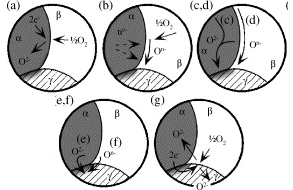Abstract
This paper reports initial studies of porous La0.8Sr0.2CoO3−δ
electrodes on samaria-doped ceria using nonlinear electrochemical impedance spectroscopy
(NLEIS). While traditional electrochemical impedance spectroscopy (EIS) involves measuring the linear response to small-amplitude potential or current
perturbations, NLEIS probes both the linear and higher harmonic contributions to the potential upon excitation by a moderately sized current modulation.
We find that these higher harmonic signals often contain specific resonant features that may help distinguish nonlinear physical processes governing
the electrode reaction. Results are compared to preliminary models incorporating various possible rate-limiting phenomena, including solid-state
diffusion and oxygen exchange at the gas/solid interface.
Graphical Abstract
